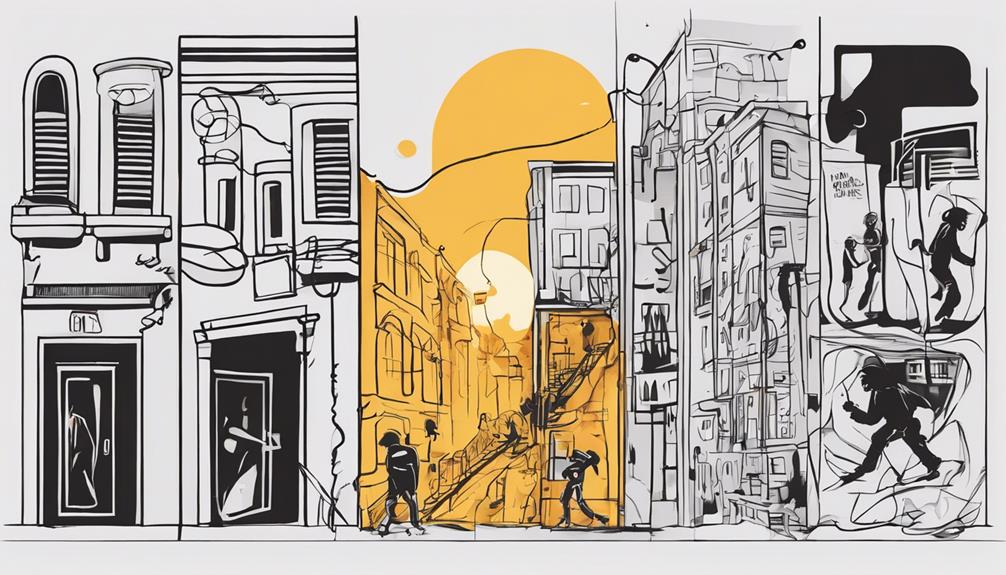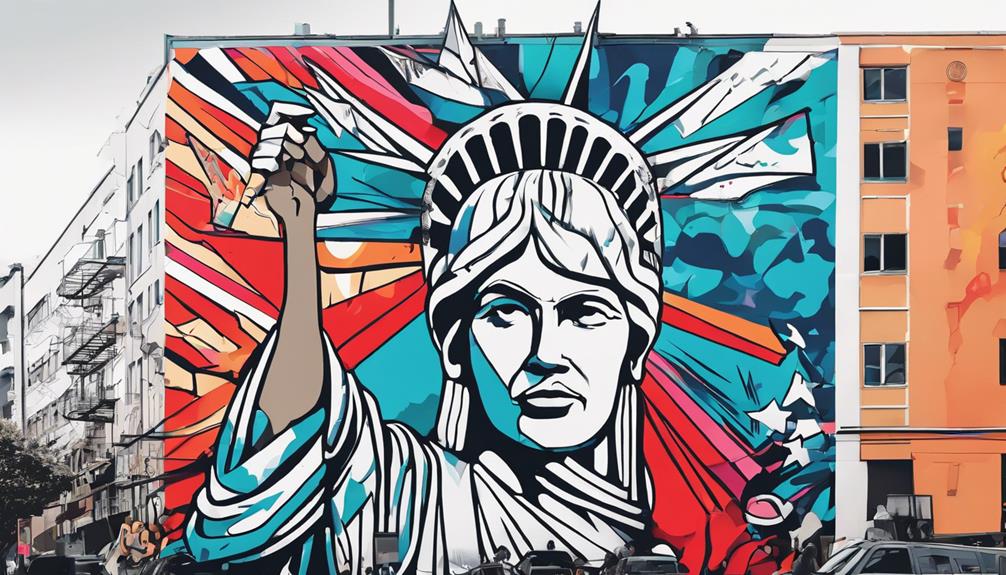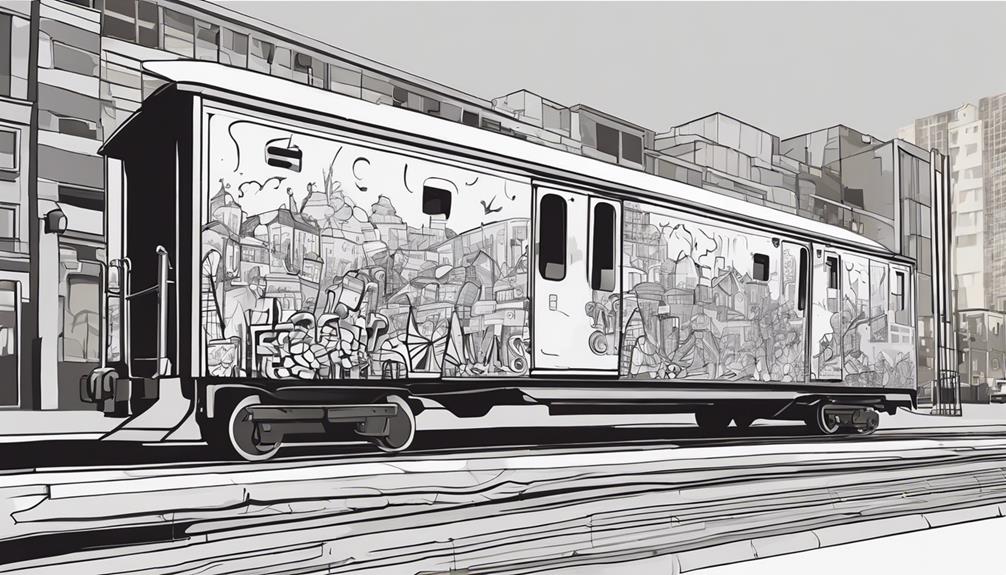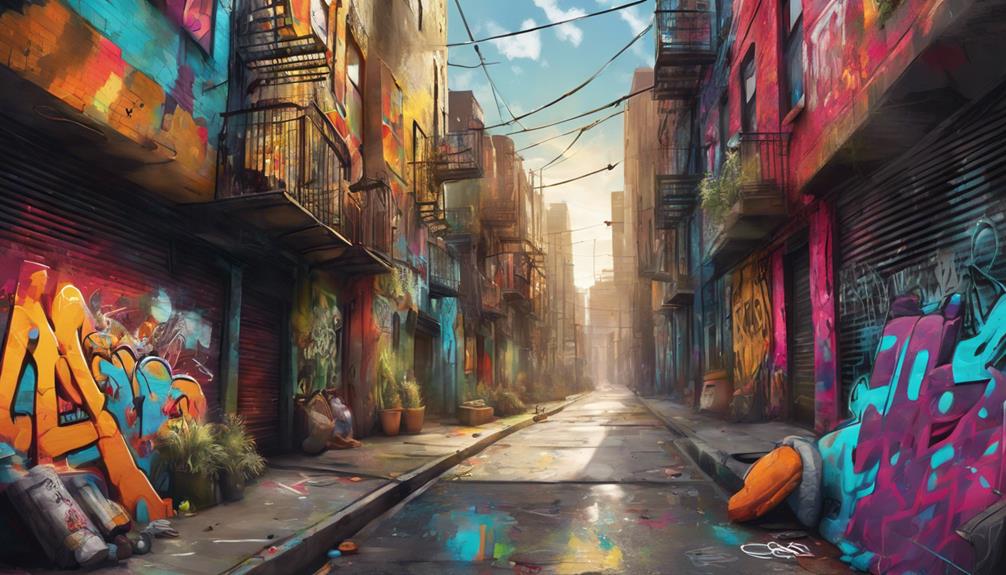Street art and graffiti, often interlinked yet distinct in their execution, play intriguing roles in the urban landscape. While street art embraces a more sanctioned form of expression, graffiti, with its roots in rebellion, continues to challenge societal norms. The dichotomy between legality and illegality, artistic merit, and vandalism drives a complex discourse on the boundaries of creativity and public space ownership. As we explore the nuances of these art forms, it becomes apparent that beneath the surface lies a rich tapestry of cultural, political, and artistic narratives waiting to be unravelled.
Key Takeaways
- Street art and graffiti originated from rebellious roots in the late 1960s and have evolved into distinct forms of public expression.
- Street art conveys accessible messages in public spaces with permission, while graffiti seeks notoriety through illegal displays.
- Political commentary in street art serves as a catalyst for social change, advocating for marginalized communities and promoting activism.
- Legalities and controversies surround graffiti, with authorities implementing strategies to manage urban disorder and provide spaces for legal artistic expression.
Origins and Evolution of Street Art

The origins and evolution of street art can be traced back to the emergence of graffiti in Philadelphia in 1967, which laid the foundation for the street art movement that took shape in the mid-1970s. Graffiti initially served as a form of creative expression for artists seeking notoriety through illegal public displays. In contrast, street art evolved with artists aiming to convey accessible messages through various forms, often in public spaces but without the same negative connotations associated with illegal graffiti. This distinction between graffiti and street art lies in their approaches to freedom of content and the influence of location and time.
Furthermore, both art forms experienced a resurgence in popularity, with techniques such as spray-painted stencils and paste-ups becoming prevalent in contemporary art practices. Street art interventions, characterized by their placement in highly emotive locations, have become a significant aspect of urban landscapes, blurring the lines between traditional forms of art and public engagement. This evolution highlights the dynamic nature of street art and its ability to transform public spaces into vibrant galleries of contemporary expression.
Cultural Impact of Graffiti Art
Cultural influences stemming from the evolution of graffiti art not only permeate urban landscapes but also resonate globally, shaping artistic expressions and societal perceptions. Graffiti and street art, often intertwined, exhibit distinctions in their execution and intent. While graffiti traditionally emerges from a rebellious, underground culture, street art tends to be more intentional, often with permission or commissioned. Graffiti writers typically operate anonymously, emphasizing the illegal risk and counter-cultural edge associated with their work. In contrast, street artists engage more openly with the public, blurring the lines between vandalism and public art. The cultural impact of graffiti art extends beyond mere aesthetics, influencing mainstream art, fashion, and design industries worldwide. Moreover, graffiti art serves as a powerful platform for marginalized voices and social commentary, fostering debates within the art world regarding its legitimacy. Some cities have embraced graffiti art by providing legal walls for artists, recognizing its value in fostering creativity and community engagement.
Significance of Political Commentary in Street Art

Political commentary in street art serves as a catalyst for social change, provoking critical reflections on power dynamics and societal norms. Street artists use their creative expressions to shed light on pressing social issues and challenge existing power structures. Through their art, they advocate for marginalized communities, denounce human rights violations, and raise awareness about environmental concerns. Political street art is not confined by borders; it can be found globally, from murals depicting political leaders to stenciled messages on public walls. The impact of such art extends beyond mere aesthetics, influencing public discourse and inspiring activism in communities worldwide.
- Street art challenges power structures
- Advocates for marginalized communities
- Raises awareness about human rights violations and environmental concerns
- Promotes social justice movements and activism
Legalities and Controversies Surrounding Graffiti
Given the contentious nature of graffiti as an art form, its legal implications and associated controversies are subjects of ongoing debate and regulation in urban landscapes worldwide. Graffiti is often considered illegal, leading to fines or even jail time in many cities. To address this issue, some municipalities have designated legal graffiti walls, providing spaces for graffiti artists to create while respecting property rights. The broken windows theory links urban disorder with graffiti, influencing its controversial perception. Authorities globally implement graffiti management strategies to combat vandalism and maintain public spaces. Legal graffiti walls and street art festivals offer sanctioned spaces for artists, contributing to urban revitalization. These initiatives aim to balance artistic expression with the upkeep of public areas, promoting creativity within the boundaries of the law.
| Legal Graffiti Walls | Broken Windows Theory |
|---|---|
| Designated spaces for graffiti artists | Associates urban disorder with graffiti |
| Respect property rights | Influences controversial perception |
| Promotes artistic expression | Implement graffiti management strategies |
| Contributes to urban revitalization | Maintains public spaces |
Perception and Misconceptions of Street Art

Street art is frequently perceived as a dynamic form of artistic expression that resonates with diverse audiences in urban settings. Despite its positive reception, there are still misconceptions surrounding street art that need to be addressed. These include:
- Misconception: Street art is synonymous with graffiti and vandalism.
- Misconception: Street artists lack talent and legitimacy compared to traditional artists.
- Misconception: Street art degrades urban landscapes and contributes to a sense of disorder.
- Misconception: Street art lacks cultural significance and artistic value.
In reality, street art holds immense cultural significance and artistic value, often serving as a platform for social commentary and community appreciation. Street artists infuse their work with a personal touch, signing pieces with their real names to establish authenticity. Communities often welcome street art for its ability to beautify neighborhoods, attract tourists, and transform blank walls into vibrant spaces for creative expression. Public perception of street art is generally positive, acknowledging its contributions to urban landscapes and art culture.
Frequently Asked Questions
What Is Street Art Vs Graffiti?
In the realm of urban expression, street art and graffiti diverge in their intentions and execution. Street art tends to target a broader public audience, utilizing images, words, and symbols to convey cultural commentary and political statements, fostering community engagement. Graffiti, on the other hand, often focuses on self-promotion and artistic rebellion, blurring legal boundaries with its illegal tagging practices. Both forms hold historical significance, but street art typically operates within legal frameworks, allowing for more creative freedom and a larger visual impact.
What Is the Definition of Street Art?
Urban expression, public creativity, and artistic rebellion define street art. Artists transform city landscapes into outdoor galleries, reflecting city culture through community murals, sparking the vandalism debate. Political statements and social commentary are common themes, often conveyed through spray paint art. Street art transcends conventional art spaces, engaging diverse audiences with provocative messages, challenging perceptions of art and public spaces.
What Is the True Meaning of Graffiti?
Graffiti's true essence embodies a multifaceted tapestry of rebellion, creative expression, and social commentary. Through its bold presence in urban landscapes, graffiti serves as a powerful political and cultural statement, challenging societal norms and fostering dialogue. While debates over vandalism persist, graffiti's historical significance lies in its unwavering commitment to artistic freedom and its ability to provoke thought, ultimately shaping the fabric of urban culture.
What Is the Main Idea of Street Art?
The main idea of street art encompasses artistic expression in public spaces to create a cultural impact through social commentary. It serves as an unconventional form of art within the urban environment, offering creative freedom and a platform for controversial mediums. Street art thrives on visual storytelling, engaging viewers in thought-provoking narratives that challenge traditional artistic boundaries. Ultimately, the essence of street art lies in its ability to transform ordinary spaces into vibrant, meaningful reflections of society.
Conclusion
In conclusion, street art and graffiti have evolved from their origins as forms of artistic expression to become powerful tools for cultural commentary and political activism. Despite legal controversies and public misconceptions, these art forms continue to shape urban landscapes and challenge societal norms. By providing a platform for diverse perspectives and visual appeal, street art and graffiti contribute significantly to contemporary art and serve as a reflection of the complexities of our modern world.
